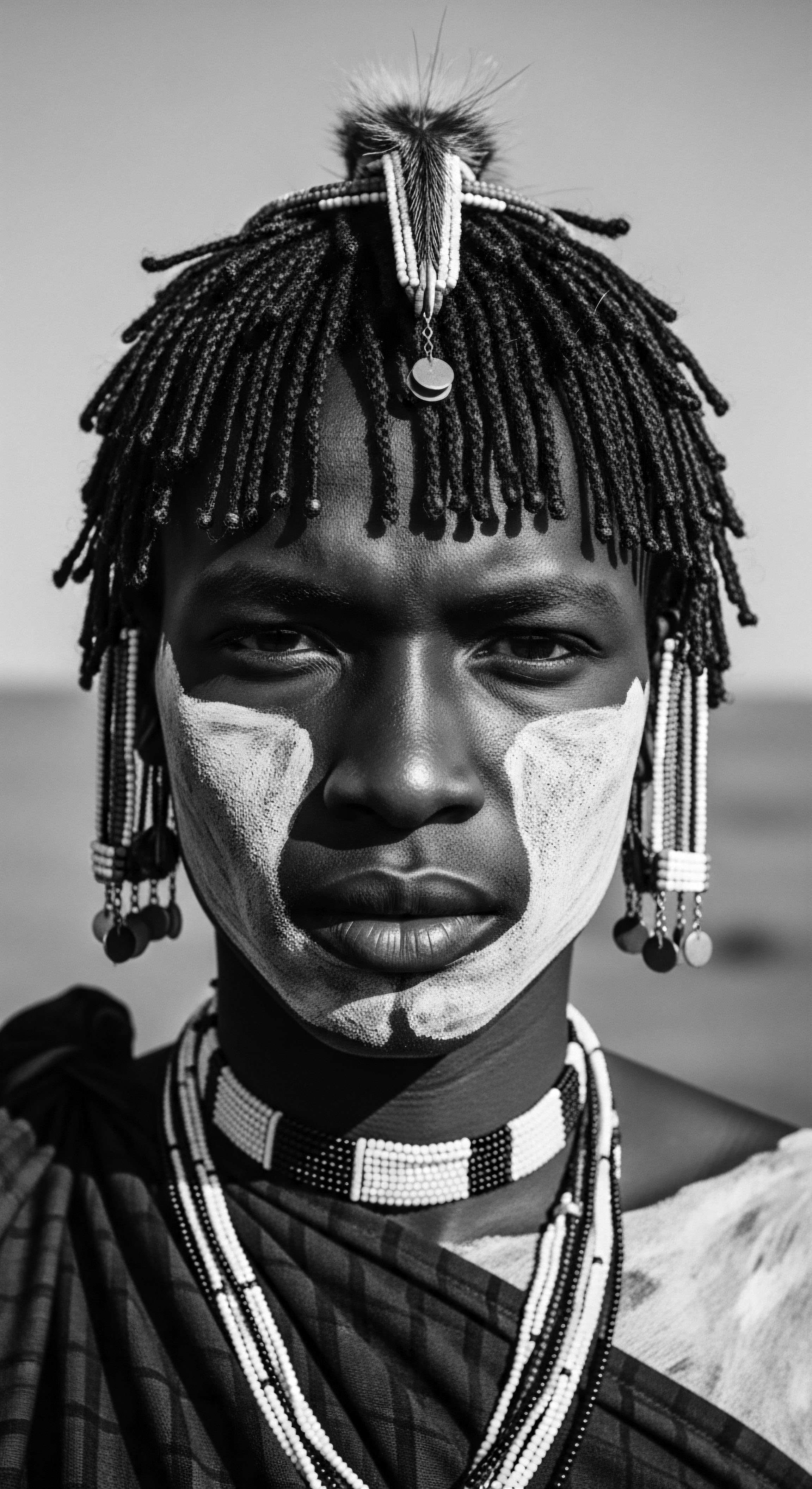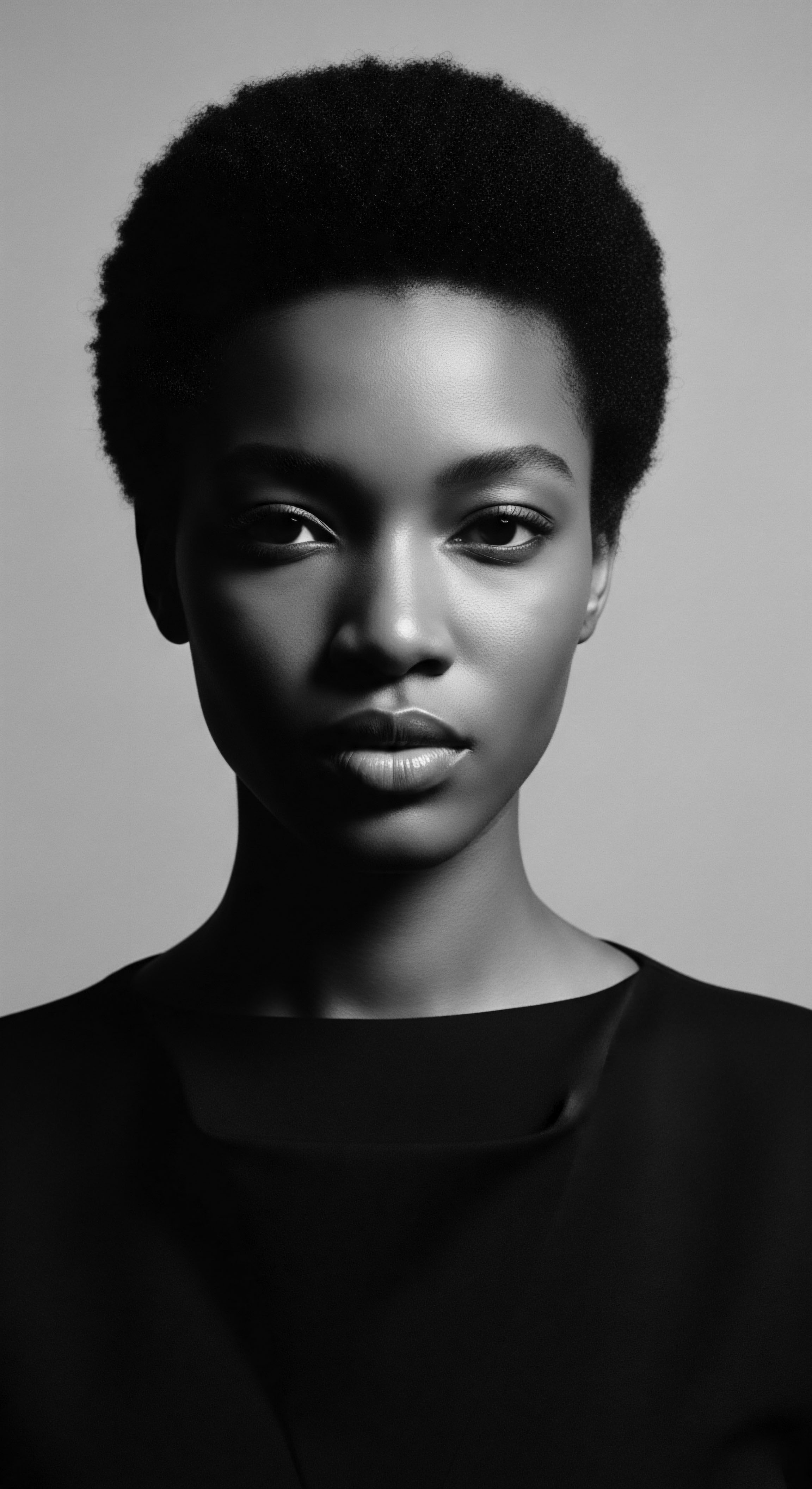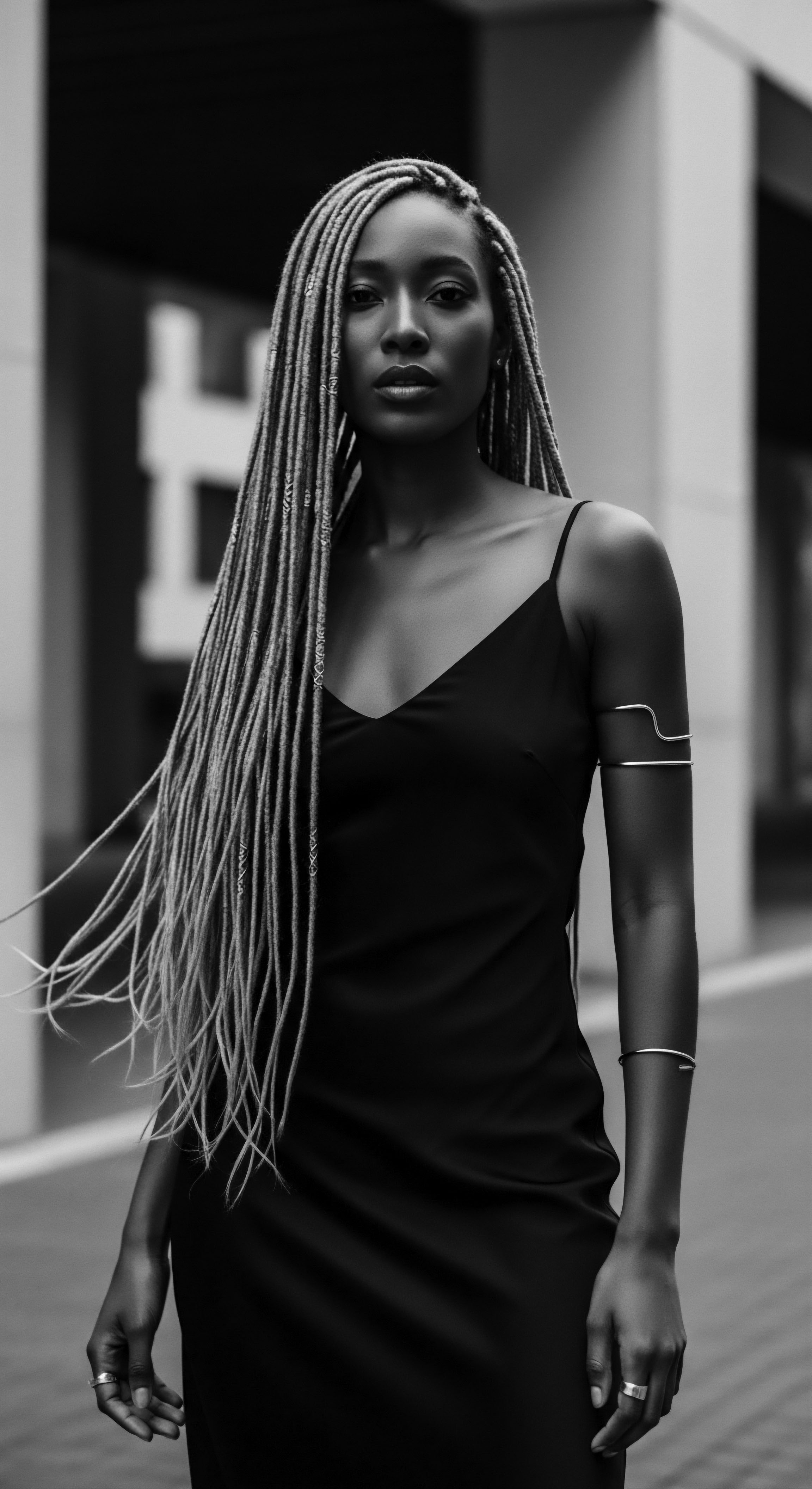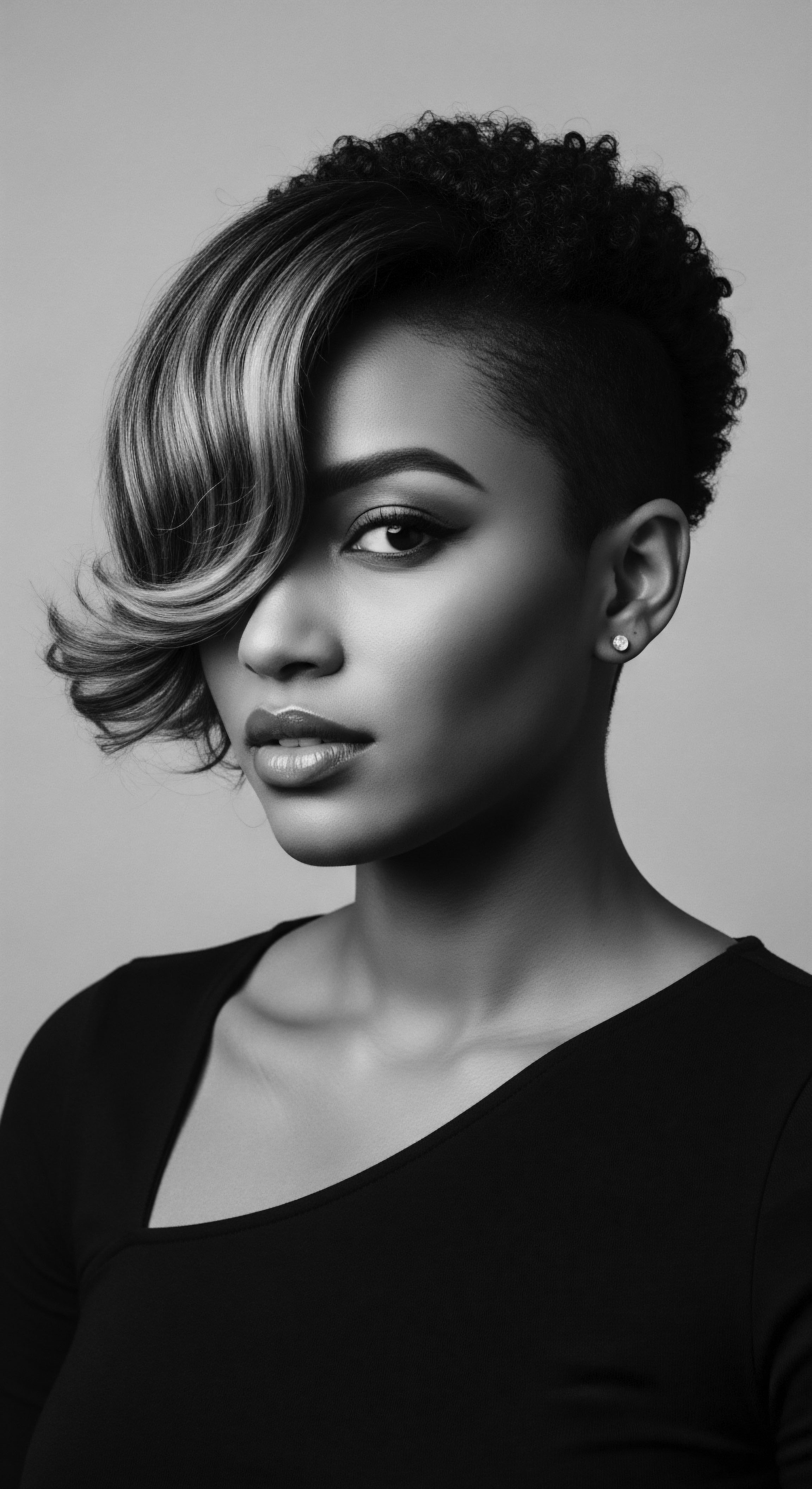
Roots
In the intricate narrative of humanity, few expressions carry the profound resonance of hair. For generations, stretching back to the dawn of civilizations, the coils, kinks, and waves that crown heads of African descent have served as living archives. They hold stories of belonging, chronicles of passage, and whispers of spiritual connection across vast stretches of time and geography.
To truly grasp what textured hair styling embodies ancestrally, one must look beyond superficial aesthetics, diving into the very essence of human experience, collective identity, and a wisdom passed down through uncountable hands. Our strands are not simply fibers; they are ancient conduits, vibrating with the echoes of ingenuity and reverence that shaped entire communities.
The fundamental understanding of textured hair begins at its biological source, a marvel of genetic inheritance that yields its distinct helical form. This unique structure, with its varied coiling patterns, determines how light reflects, how moisture is held, and how strands interact. While modern science meticulously categorizes these patterns, ancestral practices, born from millennia of observation, intuitively grasped these characteristics.
They developed specific care routines and styling methods that worked in harmony with the hair’s natural inclination, not against it. Ancient African societies, long before contemporary systems, possessed their own nuanced ways of recognizing and honoring the diverse textures within their communities, recognizing them as integral parts of a person’s heritage and a visual language.

Hair Anatomy and Its Ancestral Resonance
At a microscopic level, textured hair distinguishes itself by its elliptical cross-section and the way it spirals as it grows from the follicle. This contributes to its characteristic curl or coil. Scientists today categorize these variations, but early cultures knew these differences implicitly.
The ways in which hair strands grew were not just biological facts; they were part of an individual’s unique blueprint, often tied to their ancestral lineage and geographic origin. The understanding of this innate structure guided ancient stylists in choosing appropriate techniques, knowing which twists and plaits would hold, which would protect, and which would honor the hair’s inherent tendencies.
Consider the earliest classifications, not of a lab, but of a communal space where hands learned hair by touch and sight. These were systems built on observation, practicality, and cultural meaning. For instance, certain communities might identify hair based on its resistance to tangling, its ability to retain specific styles, or its reaction to natural elements like humidity. These were not formal taxonomies, but living definitions shaped by daily interaction with the hair itself.
Textured hair styling, from its very origins, served as a profound form of communication, mapping identity, status, and spiritual connections across generations.

The Living Lexicon of Coils and Crowns
The words used to speak of textured hair in ancient societies carried weight. They were not merely descriptors, but terms imbued with cultural meaning and historical memory. These terms often related directly to the hair’s physical properties, but also to its social or spiritual purpose.
The very act of naming a specific hairstyle, or the way it was adorned, placed it within a rich narrative of community values and ancestral wisdom. For example, the Yoruba people, for whom hair was considered the most elevated part of the body and a conduit for spiritual interaction, employed particular terms for various braided forms, each signifying a connection to deities or social roles.
The practice of hair styling, often taking hours or even days, became a communal event. It fostered deep social bonds, allowing for storytelling, the sharing of wisdom, and the strengthening of familial ties. These sessions passed down not only techniques but also the specialized lexicon of textured hair, ensuring that the knowledge remained vibrant through oral tradition. This communal approach to care and styling is a testament to the fact that hair was never an isolated individual concern, but a collective heritage.
Hair growth cycles, though scientifically defined by anagen, catagen, and telogen phases, were understood by ancestral communities through observation of length retention and overall vitality. Factors like diet, climate, and herbal remedies, known through generations of trial, were applied to support robust hair health. A woman in mourning, for example, might alter her hair, or neglect its customary styling, signifying her emotional state. Such practices illustrate a deep, intuitive understanding of the hair’s connection to physical and emotional wellbeing, long before modern scientific terms existed.

Ritual
The ancestral meaning of textured hair styling truly comes alive in the traditions of care and adornment, practices that transcend mere aesthetics to become sacred rituals. These stylized expressions, honed over millennia, represent an enduring legacy of ingenuity, self-preservation, and profound cultural memory. What is the ancestral meaning behind textured hair styling? It is a complex interplay of protective techniques, cultural markers, and acts of resistance, all woven into the everyday lives of Black and mixed-race communities.
Across African civilizations, hair styling was a highly developed art form. Hairstyles were not just decorative; they communicated a wealth of information about an individual’s identity, including their social status, age, marital status, tribal affiliation, and even spiritual beliefs. For instance, in some West African cultures, the number and direction of cornrows could signify a person’s age, social status, or lineage. This rich visual language allowed for a complex exchange of information without spoken words.

How Has Styling Shaped Cultural Narratives?
The ancestral roots of protective styling, particularly braids, are deep, dating back at least to 3500 BCE, evidenced by ancient African carvings and sculptures. These styles were not solely for beauty. They offered practical benefits ❉ shielding the hair from harsh environmental conditions, minimizing tangling, and aiding length retention.
This practicality, however, merged seamlessly with spiritual and social roles. The intricate designs often held symbolic meanings, connecting the wearer to their ancestors and the spiritual world.
During periods of immense struggle, such as the transatlantic slave trade, styling practices became acts of profound defiance. Enslaved Africans, stripped of their cultural identifiers, used their hair as a covert means of communication and a powerful assertion of identity. Cornrows, for instance, were reportedly used to map escape routes or conceal seeds for sustenance, a silent, yet potent, form of resistance. This historical example powerfully illuminates how hair styling, even under duress, became a living testament to resilience and the preservation of heritage.
The evolution of head coverings, from traditional African headwraps (known as ‘dukus’ or ‘doek’ in regions like Ghana and Namibia) to bonnets, also speaks to this heritage. Initially symbols of status and cultural identification, these coverings later became tools of oppression during enslavement, used to visibly mark Black women as lesser. Yet, Black women reclaimed them, transforming them into symbols of creative expression, self-preservation, and cultural pride.
| Ancestral Style/Practice Irun Kiko (Yoruba thread-wrapping) |
| Modern Manifestation/Purpose Contemporary thread styles, emphasizing length and delicate texture, often for protective reasons. |
| Ancestral Style/Practice Shuku (Nigerian braided crown) |
| Modern Manifestation/Purpose Updo styles and braided crowns, worn for special occasions or daily elegance, celebrating regality. |
| Ancestral Style/Practice Maasai Braids (adorned with ochre) |
| Modern Manifestation/Purpose Locs and braided styles with natural pigments, connecting to earth tones and ancestral grounding. |
| Ancestral Style/Practice These examples demonstrate how historical styling choices continue to inform and inspire modern textured hair expressions, linking past and present. |

Tools of Tradition and Transformation
The tools employed in ancestral styling were extensions of natural materials and human ingenuity. Fine-toothed combs crafted from wood or bone, pointed sticks for parting and sectioning, and various natural fibers for extensions were common. These tools facilitated the intricate work of braiding, twisting, and coiling. The use of these indigenous tools underscores a deep connection to the environment and a resourceful approach to hair care.
- Wooden Combs ❉ Crafted for detangling and smoothing, often designed to navigate tightly coiled hair without breakage.
- Parting Sticks ❉ Used for creating precise sections, essential for intricate braided patterns and uniform tension.
- Natural Fibers ❉ Materials like raffia or sisal, incorporated into styles to add length, volume, or structural support, sometimes for ceremonial purposes.
The transition from these traditional methods to modern styling involves both continuity and adaptation. While heat styling, for example, is a contemporary phenomenon with its own set of safety considerations, the underlying desire to manipulate hair for protection, beauty, or symbolic meaning remains constant. Traditional methods prioritized the health and integrity of the strand, often employing techniques that minimized stress on the hair and scalp. This ancestral emphasis on gentle, mindful manipulation serves as a guide for modern care practices, reminding us to honor the hair’s resilience.

Relay
The journey of textured hair styling, from ancient origins to contemporary expression, represents a continuous relay of knowledge, spirit, and identity across the generations. What is the ancestral meaning behind textured hair styling? It is a complex inheritance, a living library of practices that continue to shape holistic wellbeing and offer solutions rooted in deep heritage. This section explores the interplay of historical wisdom and modern understanding, demonstrating how ancestral methods laid the groundwork for today’s approach to textured hair health.
The ancestral regimen for hair care was far more than a set of steps; it was a deeply ingrained wellness philosophy. It viewed hair as a vital part of the body, intricately connected to spiritual energy and overall vitality. The head, as the highest point on the body, was considered the closest to the heavens, making hair a conduit for spiritual interaction.
This perspective ensured that hair care was never a casual act, but a mindful ritual, often performed by close family members or respected community elders. This communal aspect reinforced bonds and transmitted knowledge.
Ancestral wisdom consistently approached hair not as an isolated feature, but as a living extension of self and spirit, deeply integrated into communal and spiritual life.

Holistic Care and Ancestral Ingredients
Traditional African societies utilized a rich array of natural ingredients, sourced directly from their environment, to nourish and protect textured hair. These ingredients were selected based on centuries of experiential knowledge, understanding their properties for cleansing, moisturizing, strengthening, and promoting growth. Modern scientific analysis often validates the efficacy of these ancient remedies, affirming the astute observations of our foremothers.
One compelling example is Chebe Powder, a traditional hair care remedy originating from the Basara Arab women of Chad. These women are renowned for their exceptionally long, robust hair, often extending past their waist. Chebe powder, a blend of various natural herbs, seeds, and plants such as Croton zambesicus, Mahllaba Soubiane (cherry kernels), cloves, resin, and stone scent, does not directly stimulate growth from the scalp. Instead, it operates by coating the hair shaft, significantly reducing breakage and sealing in moisture.
This practice, passed down through generations, effectively promotes length retention, a critical aspect of hair health for coily and kinky textures prone to dryness. The Basara women’s traditional application method, similar to the modern LOC (Liquid, Oil, Cream) method, involves applying the powder as a paste to hair strands, avoiding the scalp. This specific historical example shows how ancestral wisdom, through meticulous observation and practice, developed effective solutions for hair longevity, a practice now gaining global recognition within the natural hair movement.
Other traditional ingredients played their part too, each with specific roles ❉
- Shea Butter ❉ A rich emollient, widely used for centuries to seal in moisture and provide a protective barrier for both skin and hair.
- Baobab Oil ❉ Known for its nourishing properties, contributing to hair elasticity and softness.
- African Black Soap ❉ A gentle cleanser derived from plantain skins, cocoa pods, and shea tree bark, valued for its ability to cleanse without stripping natural oils.
The application of these ingredients was often part of an extended ritual, not a rushed routine. The process of washing, oiling, braiding or twisting, and decorating the hair could take hours or even days, serving as a social occasion that strengthened communal bonds. This deliberate approach to care, deeply embedded in social structures, prioritized both physical health and spiritual connection.

Nighttime Sanctuary and Bonnet Wisdom
The importance of protecting textured hair during sleep is not a contemporary discovery; it is a practice with deep ancestral roots. Headwraps and bonnets, in various forms, have been used for centuries across African communities. These coverings protected intricate hairstyles, maintained moisture, and signaled social status. The very act of covering the hair at night was an acknowledgment of its value, a protective measure against environmental elements and daily wear.
During enslavement, head coverings took on a double meaning. While imposed by enslavers as a badge of servitude, Black women reclaimed them, using the folds in their headscarves to communicate coded messages and asserting cultural identity. This resilience transformed a tool of oppression into a symbol of defiance and cultural continuity. The modern bonnet, a ubiquitous item in many Black households today, carries this profound historical weight, serving as a practical tool for hair preservation while also being a quiet nod to generations of ancestral wisdom and resistance.
| Ancestral Nighttime Practice Headwraps/Dukus for protection |
| Contemporary Parallel/Benefit Satin/silk bonnets and scarves to prevent friction and moisture loss. |
| Ancestral Nighttime Practice Oiling/Massaging scalp before rest |
| Contemporary Parallel/Benefit Pre-shampoo treatments, scalp massages to stimulate circulation and nourish follicles. |
| Ancestral Nighttime Practice Hair preparation (e.g. loose braids) |
| Contemporary Parallel/Benefit Pineapple method, loose braids, or twists to maintain curl pattern and prevent tangles. |
| Ancestral Nighttime Practice The enduring wisdom of ancestral nighttime rituals provides a blueprint for contemporary hair care, ensuring the longevity and vitality of textured strands. |

Addressing Hair Challenges with Heritage in Mind
Ancestral practices offered solutions for hair health challenges, often drawing from an intimate knowledge of local botanicals and traditional remedies. Issues such as dryness, breakage, and scalp irritation were addressed through the application of specific oils, butters, and herbal concoctions. The understanding of these issues was often holistic, considering the role of diet, environment, and even spiritual well-being.
Today, while scientific advancements provide deeper insights into hair biology, the core principles of ancestral problem-solving remain relevant. They emphasize gentle handling, consistent moisture, and nourishment from natural sources. This fusion of ancient wisdom and modern science allows for a comprehensive approach to textured hair care, honoring both its biological realities and its profound cultural history. The historical experiences of forced hair alteration during slavery and the subsequent Eurocentric beauty standards have also shaped contemporary problem-solving, driving movements like the CROWN Act, which works to prohibit race-based hair discrimination.

Reflection
The journey through the ancestral meaning of textured hair styling reveals a truth far richer than surface appearance. It is a profound meditation on how heritage breathes life into every coil, every strand. Our exploration has shown that what we perceive today as styling is a continuation of ancient dialogues, acts of profound self-definition, and enduring legacies of resilience. The wisdom held within these traditions is a living archive, reminding us that hair is not separate from self, but a vibrant part of our story, a continuous whisper from those who came before.
From the anatomical intricacies understood implicitly by ancestral hands to the ritualistic acts of care that nurtured both scalp and spirit, textured hair styling remains a testament to human ingenuity and cultural steadfastness. The narrative of textured hair is one of defiance, of connection, and of unparalleled beauty forged in the fires of history. It is a heritage that informs our present and guides our future, reminding us to approach our strands not just with products, but with reverence. The soul of a strand, indeed, vibrates with the voices of our past.

References
- Omotos, Adetutu. “The History of African Hair.” Journal of Pan African Studies, vol. 12, no. 8, 2018, pp. 20+.
- Millner, Monica. Natural & Free ❉ Journey to Natural Beauty. 2023.
- Afriklens. “African Hairstyles ❉ Cultural Significance and Legacy.” 2024.
- NativeMag. “Examining the history and value of African hair.” 2020.
- Umthi. “The Cultural Significance and Representation of Afro-Textured Hair.” 2023.
- Byrd, Ayana and Tharps, Lori. Hair Story ❉ Untangling the Roots of Black Hair in America. 2001.
- Alicia Tenise. “Cultural Significance of Braids.” 2019.
- Chagani, Naila, et al. “What Every Dermatologist Must Know About the History of Black Hair.” Journal of Drugs in Dermatology, vol. 22, no. 11, 2023, pp. 1098-1100.
- Umthi Beauty. “The Spiritual Significance of African Hair this International Women’s Day and Beyond.” 2022.
- Byrdie. “The Significance and History of Bonnets.” 2022.
- Dabiri, Emma. Twisted ❉ The Tangled History of Black Hair Culture. 2020.
- Noireônaturel. “African braids ❉ a timeless heritage of beauty and cultural significance.” 2022.
- Helix Hair Labs. “THE HISTORY OF THE HAIR BONNET.” 2023.
- African Naturalistas. “The History of Chebe Powder ❉ An Ancient African Hair Secret for Hair Growth.” 2025.
- Shedavi. “History of Black Hair & It’s Hidden Symbolism.” 2023.
- BRAIDSTOP. “The Rich History of Braids ❉ A Celebration of African Heritage.” 2025.
- From Nature With Love. “African Skin and Hair Care Ingredients.” 2023.
- DOLAPO OBAT. “The Intricate Tapestry of African Braided Art.” 2023.
- Elom African Braids. “The History and Cultural Significance of African Hair Braiding.” 2023.
- Assendelft. “Pre-Colonial African Hairstyles ❉ A Journey Through Time and Culture.” 2023.
- New Beacon Books. “The Story Of Afro hair; 5000 years of history, fashion and styles.” 2024.
- Know Your Hairitage. “African Culture.” 2023.
- Nyela, Océane. “Braided Archives ❉ Black hair as a site of diasporic transindividuation.” Master’s thesis, York University, 2021.
- Nuevo Noir. “The history of Afro hair.” 2024.
- Smyth, Cassandra. “The African American Woman’s Headwrap ❉ Unwinding the Symbols.” Art, Design, and Visual Thinking, 2011.
- Duke University Libraries. “Hair in Black Art and Culture.” 2023.
- The Daily News. “The History and Evolution of Hair Bonnets ❉ From Traditional to Modern Styles.” 2024.
- Chicago Public Library. “Celebrating Black Hair ❉ Books for Adults.” 2021.
- Nrenzah, Genevieve. “Religion, Aesthetics, the Politics of Hair in Contemporary Ghana.” American Religion, 2023.
- Wanjiru, Lydiah. “Rhetoric of Natural Hair ❉ Cultural Contradictions.” Scientific Research Publishing, 2017.
- Kilburn & Strode. “Afro-texture ❉ a hair-story.” 2021.
- Stylist. “This new book celebrates the rich cultural history of Black hair.” 2023.
- Roy, Aparajita and Mandal, Indranil. “Re-Centering Black Pride In Americanah ❉ A Psychoanalytic Approach To Diaspora And The Politics Of Black Hair.” Journal of Positive School Psychology, 2022.
- PushBlack. “The History Of Head Wraps In Black Culture.” YouTube video, 2023.
- Formula Botanica. “10 Natural African Skincare Ingredients.” 2021.
- Africa Imports. “Traditional African Secrets For Long And Healthy Hair.” 2025.
- Elsie Organics. “Chebe Powder ❉ Everything You Need to Know.” 2022.
- Beautycon.com. “Texture Tales ❉ Maxine Celebrates Her Ancestry By Embracing Her Curls.” 2019.
- Croda Beauty. “Textured hair – Hair care trend.” 2024.
- USC Dornsife. “Kinky, curly hair ❉ a tool of resistance across the African diaspora.” 2016.
- The Kurl Kitchen. “The Cultural Significance Of Natural Hair In Different Communities.” 2024.
- Nartey, Esther and Nartey, Michael. “The importance of hair in the identity of Black people.” Nouvelles pratiques sociales, 2021.
- Nwadiora, Emeka and Williams, Nsenga. “Hair It Is ❉ Examining the Experiences of Black Women with Natural Hair.” Journal of Negro Education, 2009.
